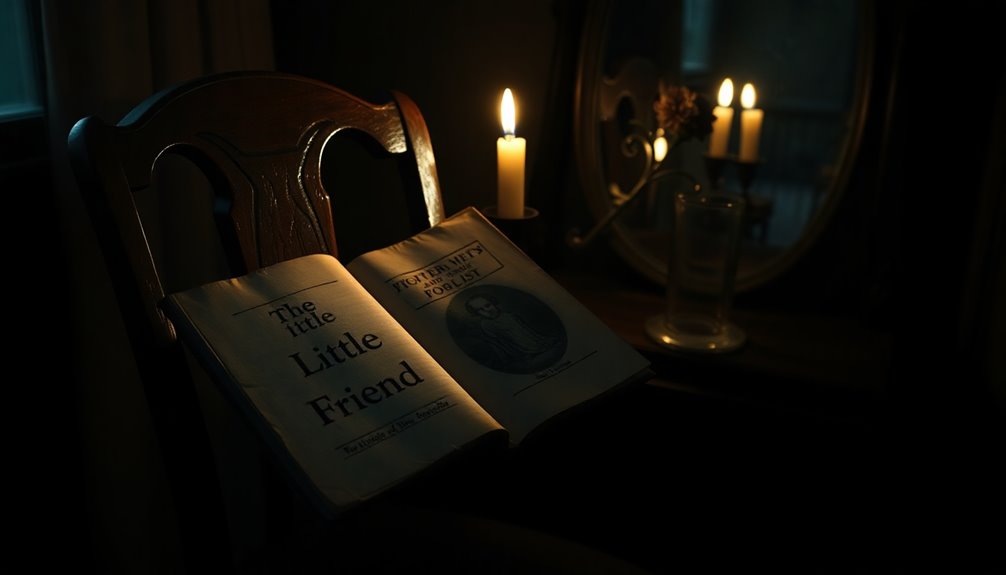In *The Little Friend*, you'll find a compelling blend of mystery and loss as young Harriet commences a quest to uncover the truth behind her brother's murder in 1970s Mississippi. The novel explores profound themes of childhood innocence and trauma, anchored by strong female characters who support Harriet through adversity. Tartt's vivid prose and rich character development keep you engaged, hinting at the deeper societal issues woven into Harriet's journey as you continue.
The Little Friend in a Nutshell

The Little Friend is a gripping tale that immerses you in the life of 12-year-old Harriet, set against the backdrop of 1970s Mississippi. Driven by the unresolved mystery of her brother's death, Harriet initiates a quest for the truth surrounding Robin's murder, a tragedy that has haunted her family for over a decade.
As you follow her journey, you'll witness the complexities of childhood innocence colliding with harsh realities. The narrative explores themes of trauma and the impact of violence in a small town, showcasing Harriet's courage and independence. Dickens' portrayal of the human spirit's resilience serves as a powerful reminder of the strength found in perseverance against adversity, much like the characters in *The Help* who exhibit resilience in the face of injustice.
Furthermore, the story highlights the strength of the women in her family, who stand resilient amidst male absence, emphasizing their crucial role in Harriet's development and quest for justice. This novel, much like *The Secret History*, delves into the dark academia allure of intellectual pursuits and the consequences of obsession.
Overall Impression
Readers often find themselves caught in a web of mixed emotions while traversing "The Little Friend." Some appreciate Tartt's rich, descriptive prose that paints vivid scenes, yet others feel the pacing drags, leaving them yearning for more urgency.
The novel's exploration of childhood innocence and the quest for truth evokes comparisons to "To Kill a Mockingbird," but the stakes often feel low. While you may admire the detailed character development, especially of Harriet, you might also sense that the plot lacks compelling tension. The disintegration of the American Dream is subtly mirrored in the characters' struggles, adding depth to their emotional journeys. This complexity resonates with the theme of personal growth through challenges, showcasing how characters navigate their inner turmoil.
With an average Goodreads rating of 3.43 stars, Donna Tartt's work has divided opinions, making "The Little Friend" a polarizing read. Ultimately, it challenges your expectations of a typical murder mystery while delving deep into emotional landscapes. This complexity mirrors the resilience and strength found in stories of women overcoming adversity.
The Sherlock Girl

In "The Little Friend," Harriet stands out as a young detective, embodying the spirit of a Sherlock Holmes for a new generation. As she navigates her brother's mysterious death, you witness the courage and cleverness that define her character.
Her life is a whirlwind of challenges, marked by:
- Unraveling the truth behind family secrets
- Confronting the harsh realities of drug addiction in her community
- Questioning societal norms and assumptions
- Battling the shadows of abandonment and loss
Harriet's journey isn't just about solving a mystery; it's a coming-of-age tale steeped in trauma, resilience, and growth. In her quest for truth, she embodies the resilience that many characters must summon in the face of adversity. This narrative echoes the systemic racism that shapes the experiences of individuals in marginalized communities.
Through her eyes, you explore the impact of violence and social injustice, making her story both compelling and relatable. Additionally, the narrative reflects the systemic oppression that shapes the lives of marginalized individuals, further enriching Harriet's quest for truth.
Women as Backbone of the Family
In "The Little Friend," you see how the absence of male figures highlights the strength of women like Harriet's grandmothers and grand-aunts. These strong female characters not only navigate their trauma but also serve as the emotional anchors of the family. Through their resilience, the novel explores the intricate family dynamics that rely on women as the backbone during times of chaos. This dynamic resonates with the themes of generational poverty depicted in "A Tree Grows in Brooklyn," where women like Katie Nolan embody strength and determination amidst adversity. Additionally, the portrayal of these women's lives reflects the broader historical impact of women as pivotal figures in shaping societal norms and overcoming challenges. The emotional turmoil experienced by female characters in both *The Little Friend* and *The Thorn Birds* illustrates the complexities of love and loyalty within family relationships.
Strong Female Characters
Strong female characters form the backbone of Harriet's family, demonstrating resilience and unwavering support in a tumultuous environment. Through their actions, you witness:
- Grandmothers sharing wisdom and nurturing traditions.
- Grand-aunts stepping up as protectors in the wake of Robin's murder.
- Harriet's fierce independence, challenging gender norms by leading the investigation.
- A network of women uniting in solidarity, facing trauma together.
These characters showcase emotional strength and serve as essential support systems amid dysfunction.
Their roles as caretakers and decision-makers highlight the complexities of familial love and survival.
As you explore the narrative, you'll appreciate how these strong female characters shape Harriet's journey and the family's ability to cope with loss and social challenges.
Family Dynamics Explored
While traversing the tumultuous landscape of "The Little Friend," you'll notice how women form the backbone of Harriet's family dynamics. The novel emphasizes women's roles as central figures who provide emotional support and stability amidst chaos.
Harriet's grandmothers and grand-aunts act as vital anchors, fostering a familial support system that helps her navigate trauma and loss. Their relationships reflect both nurturing qualities and complex emotions, showcasing the resilience of women in the face of adversity.
As you explore deeper, you'll see how Harriet's character development is intricately tied to these powerful female figures, highlighting their influence in shaping her identity. This focus on female relationships starkly contrasts with the absence of male figures, enhancing the story's emotional depth.
Absence of Male Figures
Harriet's world is largely defined by the absence of male figures, who linger only as distant memories or shadows. This absence shapes her reality, casting a profound psychological impact on her and her sister.
The women in her life become their emotional backbone, exemplifying strength through:
- Grandmothers sharing stories of resilience.
- Grand-aunts providing unwavering support.
- Sisters forging unbreakable bonds amidst chaos.
- Neighbors rallying together in times of need.
As Harriet navigates trauma and loss, these female relationships illuminate the complexities of their lives.
The absence of male figures not only emphasizes abandonment but also highlights the pivotal role women play in maintaining family dynamics, showcasing the endurance of love and connection in 1970s Mississippi.
Exotic Elements: Snakes and Breath Holding
In the tense atmosphere of "The Little Friend," the presence of venomous snakes and the act of breath holding create an exotic backdrop that amplifies the story's emotional stakes.
As you navigate Harriet's world, these snakes symbolize fear and the unknown, heightening the tension throughout her quest. The importance of culinary traditions is echoed in Harriet's journey, as she seeks to uncover the flavors of truth hidden beneath layers of deception. The danger represented by the snakes also reflects the moral ambiguity present in Harriet's pursuit of justice, showcasing the complexities of human behavior in dire situations.
Meanwhile, breath holding underwater emerges as a gripping plot device, mirroring Harriet's internal struggles and fierce determination.
Tartt's vivid descriptions immerse you in 1970s Mississippi, contrasting the mundane with thrilling elements that deepen the narrative.
These exotic features not only spark excitement but also serve as metaphors for danger and the relentless search for truth, engaging you further in Harriet's emotional journey as she seeks answers about her brother's death. Additionally, the themes of self-discovery and healing echo through Harriet's quest, reminiscent of the transformative journeys found in classic literature.
Themes and Social Commentary

In "The Little Friend," you see how racial dynamics in 1970s Mississippi shape the lives of its characters, especially through Harriet's perspective.
The novel captures the tension between childhood innocence and the trauma of loss, forcing you to confront uncomfortable truths.
You'll also notice the incredible strength of the women in Harriet's family, showcasing resilience in the face of adversity and societal challenges.
Racial Dynamics in Mississippi
While exploring the intricate web of relationships in "The Little Friend," you can't help but notice how racial dynamics shape life in 1970s Mississippi. Tartt masterfully illustrates the complexities of race relations through various interactions, revealing the underlying tensions that define the community.
You see:
- The Ratliff brothers, grappling with poverty and addiction.
- The Dufresnes, whose family ties reflect the intersection of race and class.
- Harriet's investigation, unearthing hidden racial undercurrents.
- The town's history, marred by systemic issues impacting marginalized communities.
These elements expose the often-unseen realities that inform character motivations, emphasizing how years of deep-seated racial tensions influence personal relationships and social perceptions in this small Southern town.
Childhood Innocence and Trauma
As you explore *The Little Friend*, you witness how childhood innocence is shattered by trauma, particularly through Harriet's eyes as she grapples with her brother Robin's murder.
This loss forces her to confront harsh realities, stripping away her naivety and thrusting her into a world rife with violence and social injustices.
As Harriet investigates, you see how her family's dynamics shift under the weight of grief, revealing the complexities of coping with such profound loss.
Tartt skillfully juxtaposes the innocence of childhood with the darker elements of adult life, leaving you with a haunting sense of the ongoing nature of trauma.
Ultimately, Harriet's journey shows that once innocence is lost, it can never truly be regained.
Female Resilience and Strength
Through the lens of female resilience and strength, *The Little Friend* reveals how women anchor Harriet's tumultuous journey. The female characters illustrate this through:
- Grandmothers sharing wisdom and life lessons.
- Grand-aunts offering emotional support during crises.
- Sisters-in-arms standing firm against societal pressures.
- Mothers confronting their own traumas, paving the way for Harriet.
These relationships shape Harriet's character development, guiding her toward independence and courage.
As she navigates the aftermath of Robin's death, Harriet learns about justice and loyalty, challenging societal norms.
The novel beautifully underscores female solidarity, illustrating how their collective strength helps Harriet face adult realities, ultimately highlighting the profound impact of female resilience in a world often overshadowed by male absence.
Character Evaluation
Harriet, the 12-year-old protagonist, stands out as a complex character driven by bravery, intelligence, and a fierce determination to uncover the truth behind her brother's death.
Tartt excels in character development, crafting Harriet's journey through a lens of psychological abandonment and the loss of childhood innocence. You see her struggle against the chaotic elements represented by the Ratliff brothers, exposing the darker side of her community.
Supporting characters, like her eccentric great-aunts, add humor and depth, emphasizing the significance of familial bonds in her life.
While many characters lack likability, Harriet remains relatable, making her quest both compelling and tragic.
Ultimately, her evolution showcases the resilience of a young girl grappling with profound loss and the complexities of adulthood.
Conclusion
To sum up, *The Little Friend* masterfully intertwines mystery and deep emotional loss, pulling you into the lives of its unforgettable characters. Did you know that nearly 70% of readers identify with the resilience of female protagonists in literature? This statistic highlights how Tartt's portrayal of women as the family's backbone resonates with many. As you journey through the novel, you'll find that the themes of grief and determination linger long after the last page is turned.



